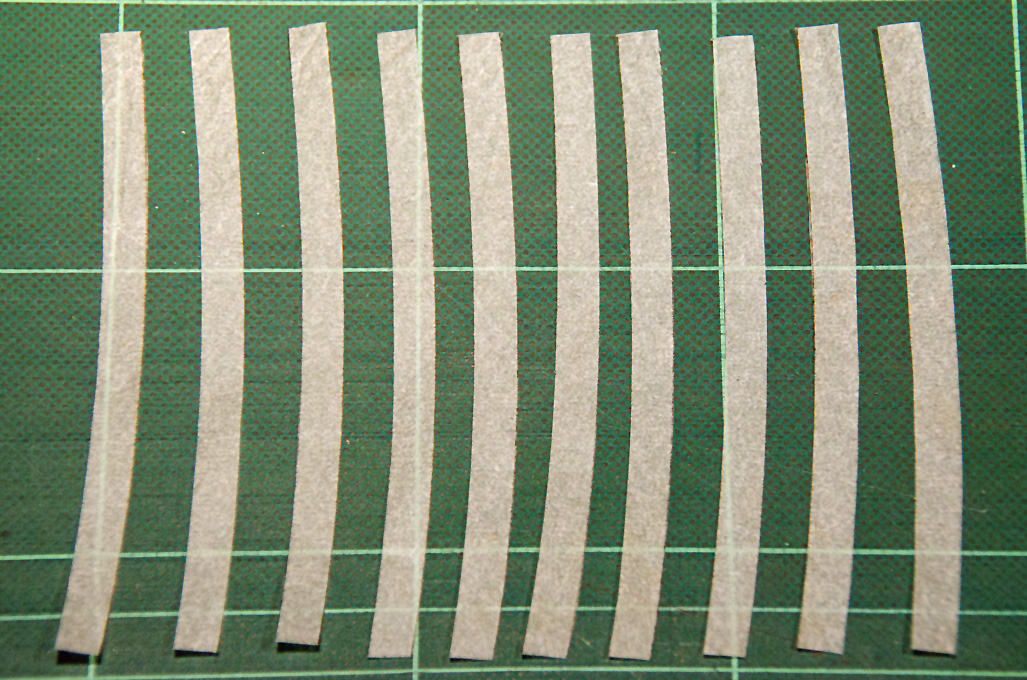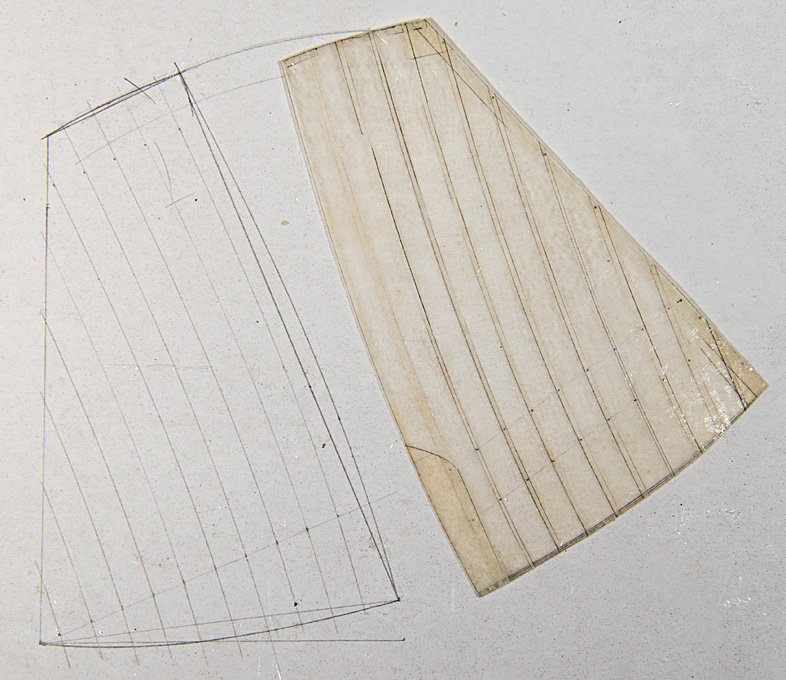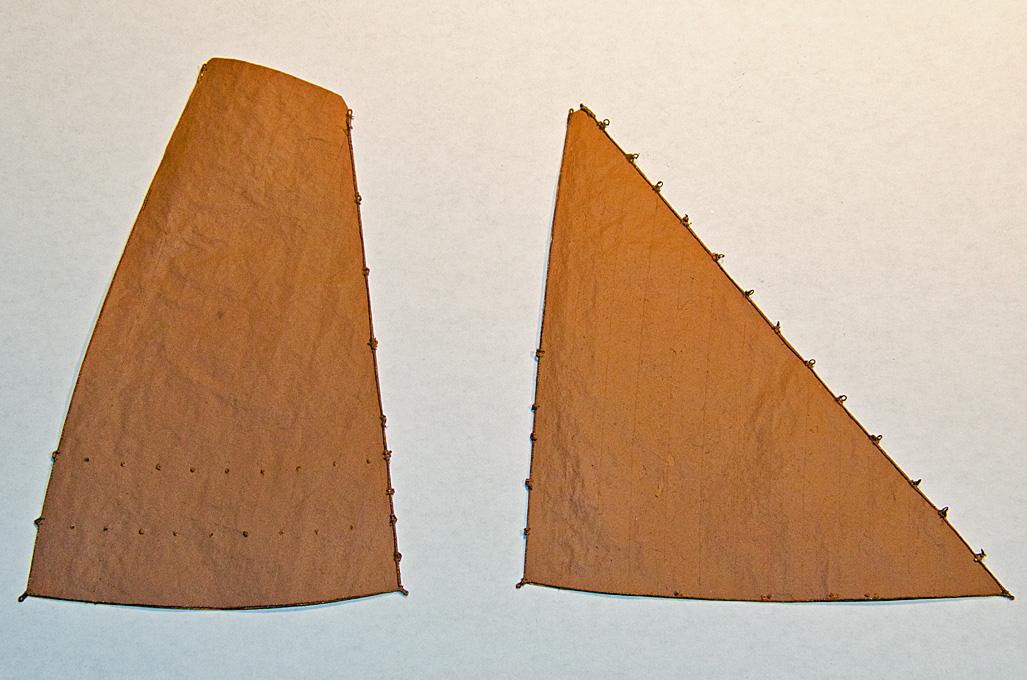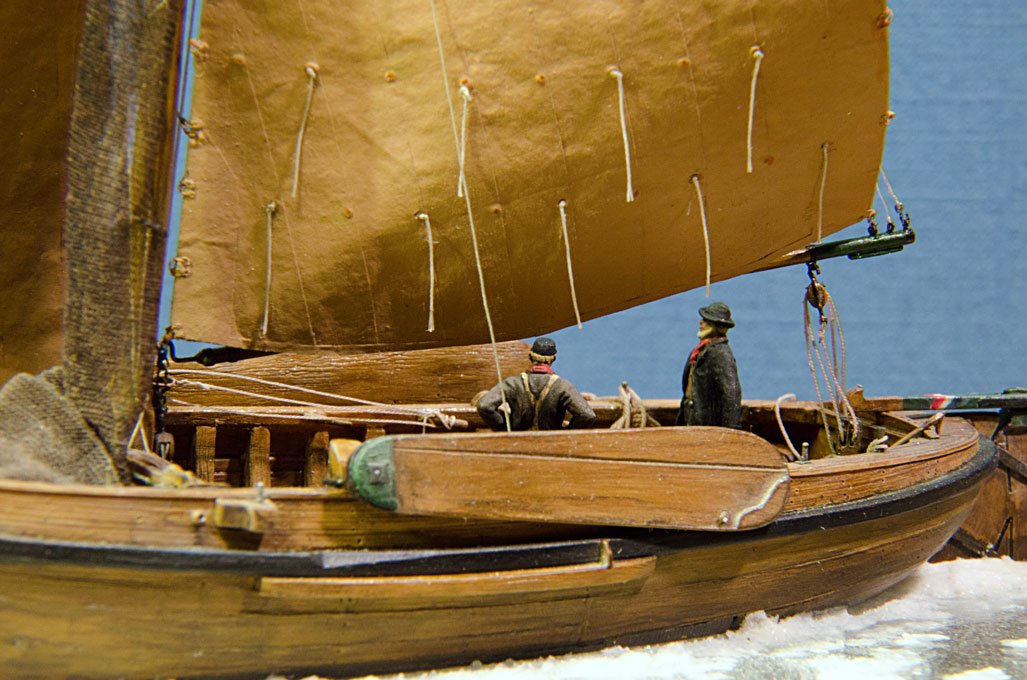-
Posts
6,624 -
Joined
-
Last visited
Content Type
Profiles
Forums
Gallery
Events
Everything posted by wefalck
-
What are 'turbo' carvers ? Any picture or link ?
-

Lancia Assunta by maurino
wefalck replied to maurino's topic in - Build logs for subjects built 1901 - Present Day
Looking at the sail, I am wondering, why you have both ends of the reefing points at the same side of the sail ? Was this indicated so in the kit instructions ? Normally, they would go from one side to another, secured in the middle by a kind of not and or sewn onto the sail on one side. Below is an image of a slightly larger boat type (also with painted sails) from the lagoon in Venice in the Naval Museum there: -

Thinning Paint
wefalck replied to Ed Gibbons's topic in Painting, finishing and weathering products and techniques
Enamel as on pots is something different from 'enamels' as in paints ... Enamel as on pots is a layer of glass. It is applied as a layer of a glass-powder mixed with some flux on the bare metal, which is then heated in a furnace to the melting temperature of the glass. A technique thousands of years old. I believe 'enamels' as in paints are named so because they form a hard and smooth layer resembling real enamel. -
Re. the bottom of the archipelago ... I am a geologist, after all, who studied in Kiel I tried small paint rollers on paper sails, but it does not work very well, as it leaves a slightly rough surface - foam is better than fleece. However, spray-painting is the best solution. At the beginning I used the frame-method or suspended the paper from its corners. Today, I cover a piece of cardboard with clingfilm and lighly tape the paper onto this - make sure to not wet the paper too much, as then the back will not look nice, with paint accumulating at certain points due to capillary effects. In this way I also make 'built' sails, i.e. sails composed of individual paper strips to simulate the cloths and doublings.
-
I gather the bottom of the archipelago would be glacial till with a lot of pebbles of various sizes on the surface, so a grapnel would be a good choice.
-

Help from German speaking readers needed…
wefalck replied to Waldemar's topic in Nautical/Naval History
Although a native German speaker, I did not chip in before, as I had some difficulties deciphering the script. I think the final 'free' translation is pretty good. Was there a ship in the fleet of question by the the ARCA NOË ? I have difficulty reading the last three(?) words in the first sentence: ullb (or ulls?) auff der Lersnusa(?). One would need to compare the letters with others in the document that can be clearly identified by the context. It was (and I used this for a time myself as well) to distinguish in handwriting 'n' from 'u' by putting a hook over it: Ŭ. What you interpreted, at least at the beginning as 'tb', the symbol that looks a bit like a 'w' with a curl through it is the old abreviation for 'libra' = lb = pound. I am not so terribly well educated in the details of German language history, but there has been a transition sometime between the 17th and 18th century from 'scheißen' (or scheiszen or scheissen) to 'schießen', i.e. the meaning of to shoot separated from to ****. The verb 'zerspringen' (or only springen) was used to describe to burst or to explode, depending on the context up to the end of the 19th century in the context of artillery, a grenade 'zerspringt' (past tense 'zersprang') while today we would say it 'explodiert'. The same for a gun barrel. Today we would rather say 'bersten'. Neither of German, Dutch, Swedish or Danish, was very standardised (perhaps German the least) as to the spelling and also the vocalisation (which still does vary in modern spoken German depending on where in the country the speaker originated from) in the 17th century. So one can observe variations even within the same text. Somehow the text reads as if there was some Swedish or Danish influence. It is correct that gun-metal is more ductile than cast iron, but I would still use the term to burst, rather than to split, because the failure was usually due to casting failures (foreign substance in the metal, untempered stresses from the casting process, micro-fissures due uneven cooling, etc.) that could go undetected (there was no ultrasonic or radiographic testing at that time ) by inspecting the barrels by hammering at it. Such failures would result in fragmentation as for cast iron barrels. -
Kevin, at that time either oil-based paints or (shellac) lacquer based paints and varnishes would have been available. Oil-paints, when new can be quite glossy, but it also depends on the pigments and other accessories used in the paint formulation. When exposed to the wheather, it would dull. Oil-paints remain a bit elastic, so would be well suited to paint structures such as coaches. Shellac-based paints, being harder, could be polished to a very high gloss, but would be more prone to cracking. Colourless shellac varnishes of wood can be polished to your wishes, between satin and high gloss, and would be quite tough. On the other hand they are not really weather resistant. I think the wood-work would have been either painted with an lineseed oil-based paint, or be treated just with lineseed oil.
-
Talking about paint-schemes: over here in continental Europe I think by the early 19th century most stage-coach services were state-run in one way or another, with inns being sort of franchises. The coaches were mostly painted yellow with black iron-work and lining. Also leather-work including roofs, boot covers, etc. was black.
-
I gather, such questions are difficult to answer, which is why no-one chipped in so far. Internally strapped blocks require the manufacture of rolled iron-bars and the possibility to drill accurate and matched holes for the axle. This kind of manufacturing technology only became available around the second quarter of the 19th century. That should give you a time frame. This kind of marine technology diffused quickly around the world and was adopted, where the respective manufacturing technology was available together with the necessary raw materials.
-
Actually the same techniques can be applied to wood, metal, and plastics. I prefer metal or acrylic glass for small parts over wood, as I then don't have to worry about the wood-grain. If you need to have the parts look like wood, it is quite easy to simulate this with paint. I have, for instance, milled the cleat-shape from a suitable rectangular brass profile and then sliced off individual cleats. If you let a spigot protruding from the foot of the cleat, you have something to hold it in a pin-vice for further shaping operations and, of course, for mounting it later on. The same technique works for acrylic-glass, which is easier to shape, but more brittle than brass.
-

Idea : Printing fabric sails using heat transfer paper
wefalck replied to modeller_masa's topic in Masting, rigging and sails
Allen et al., this is the heat-activated paper repair I talked about: https://www.neschen.de/en/product/filmoplast-r-2/#pdetails. Not sure about the availability outside Europe, but I am sure there are equivalent products, as all around the globe paper- and book-restorers face the same challenges. The prices are not Chinese supermarket prices, but a roll 50 m long and 20 mm wide will probably get me through all the models I am likely to build in the next three decades, before I am getting too old and tatty for this. -

Idea : Printing fabric sails using heat transfer paper
wefalck replied to modeller_masa's topic in Masting, rigging and sails
I have been tossing around the idea of using ink-jet or (colour) laser printed for a couple of decades or so. The biggest issue is the light-fastness of the pigments they use. There are various studies on the Internet, where people used (accelerated) test on different combinations of inks/toners and papers. Very few really hold on over more than a few years. Reds are notorious for their fading. So my conclusion was to stay away from home-printed parts. OK, there may have come new inks/toners onto the market since I did my survey, so I may be wrong .... I have used, however, b/w printing to give me the layout, which I then painted in acrylics, say for flags. We had the discussion on sail materials several times in recent years here. I fully agree with Allen, that cloth in most instances is not a suitable base for scale sails except at very large scales. Paper can be at least an order of magnitude thinner than the thinnest woven fabric. The problem with many papers is that their wet tear-resistance can be rather low. A friend of mine started experimenting with a special paper as used by book- and paper-restorers. This is a long-fibred rice-paper coated on one side with a heat-activated acrylic glue. When applied onto a sheet of paper, it is almost invisible. My friend made three-ply sails with this special paper on the outside and a core of thin silk-paper in the middle. In this way, he achieved three things: the sail has a reasonably good wet tear-resistance to be shaped, painted and handled, it is translucent, if only thin washes of acrylics or inks are used, and by cutting the outer layers into strips of the scale-width of the sail-cloths, the seams are reproduced to near scale thickness. I have not tried this myself yet, but it seems to produce quite impressive results for set sails. I have to make some trials, to see how it works for gathered or brailed-up sails. -
Iteresting trials, indeed. The importance of the colour of the primer reduces as one increases the thickness of the paint layers, but this will also depend on the pigments in the paints. For 'gilding' another option might be 'gold' leaf (e.g. https://www.amazon.co.uk/Imitation-Metallic-Handicrafts-Decoration-Furniture/dp/B0924GTH3P/ref=sr_1_7?crid=1CR56NNXM68RG&dchild=1&keywords=krylon+foil+metallic+gold&qid=1628411413&sprefix=Krylon+Foil%2Caps%2C654&sr=8-7). At this price it is not real gold, but brass hammered out very thinly. Most of it comes from China these days. Got a booklet like this, but did not yet around to try it out. Being brass, it probably needs a protective varnish, such as used to protect brass- and silver-ware. The gold-leafe is applied on a slightly tacky lacquer and then burnished with a steel or agate burnisher (the latter one can get from craft shops that cater for porcelain painters). I am not sure that I would have used primer at all on the white-metal parts. I would probably burnish them and then apply the paint directly. Primers contain pigment/fillers and these always roughen the surfaces compared to burnished metal. That is ok for coloured surfaces, where you want the the paint to key into the primer, but for 'metal' surfaces, the surface roughness of burnished metal would be the best you can get.
-
These cooking stoves were in reality quite complex pieces of engineering, that were also designed to minimise the risks from handling open fire in an environment tremendously susceptible to fire-hazards. Well done !
-
Didn't look into this thread for a while. It is coming on very nicely, the diorama. Love getting lost in detail ... The Jordan kits seem to have been available over here in the mid 1970s. I vaguely recall a review/building log in a German modelling magazine then. People were amazed by the detail in that scale. I remember envying other kids in the early 1960s, who had inflated tubes to go onto the water. My father never let me have one - perhaps because I wasn't able to swim yet at that time ... it was also difficult to carry the thing inside the car, when we were going down to the Rhine river on the summer weekends - it had to be inflated at a filling station.
-
I think Håkan is right, the term 'tabernacle' also came to my mind. In other languages, e.g. German it is als called a 'mast-stool'. Otherwise I silently follow the evolution of this project. I find the choice of dark wood a bit sombre, but really like what you are doing with it !
- 153 replies
-
- Ancre
- Bruno Orsel
-
(and 2 more)
Tagged with:
-
Copper wire down to 0.05 mm is readily available from electronic supply stores or through the Internet. For small unstudded chains, such as used for hand-rails, I developed the following procedure: take two wires of the diameter that is appropriate for the scale wire diameter of your prototype; twist them together, so that the length of each twist is about the length of scale chain link; half the twisted wire and twist together the two halfs into the opposite direction with the same amount of twists - the result looks like a twisted chain. May need a bit of practice to get this done smooth and evenly. For galvanized chain - common from the late 1840s onward, I start with either blackened copper-wire and slightly dry-bush it in silver, or I take tinned copper-wire and let black ink/acrylic run into the depressions after twisting. For anchor-chains, of course, you need to check the protype dimensions and chose the right scale link sizes - there is no 'one-size-fits-all' or something like '1/700 scale anchor chain' ...
-

Lancia Assunta by maurino
wefalck replied to maurino's topic in - Build logs for subjects built 1901 - Present Day
Where in the Adriatic does the prototype actually come from ? -

Brass piano hinges
wefalck replied to Chariots of Fire's topic in Metal Work, Soldering and Metal Fittings
'Chariot', have you tried ebay-shops (usually Chinese) selling hardware for jewellery-making and associated stuff ? The variety of items there you may have never seen or heard off before is quite amazing ... Otherwise, a DIY-process as Bob suggested may be the only solution ... check out the building logs of Michael Mott and KeithAug, if I remember correctly, at least one of them has done such small hinges. -
The tighter you wind the strands, the harder and stiffer they become - which means that the two pairs will slip past each other, with the final product looking like a three-stranded rope with a fourth strand running along a groove (diamond-shaped cross-section). Perhaps you rope was soft enough so that the strands squeezed together ... Making a ropewalk yourself and according to the dimensions you need is not really magic and certainly within the capabilities of anyone, who arrived at the stage, where he feels the need for proper rope ... the parts, such as gear wheels, bushings or ball-bearings, rods for axles etc. are readily available on the Internet; the other materials one can get at any DIY store. Unless one needs to produce hundreds of metres of rope, I find single-use machines, such as those of Domanoff rather expensive for the use they will get.
-
It is also quite possible to assemble silkspan-sails from individual panels and add doublings etc.: Cutting the panels from a sheet of silkspan stabilised with acrylic varnish Assembling the sail using acrylic varnish as glue Boltropes, cringles etc. attached as per Allen's description, sail also painted to look 'tanned' Sail rigged and reefing ropes attached It also works with what is called silkspan over here in Europe, that is a very thin silk cloth.
About us
Modelshipworld - Advancing Ship Modeling through Research
SSL Secured
Your security is important for us so this Website is SSL-Secured
NRG Mailing Address
Nautical Research Guild
237 South Lincoln Street
Westmont IL, 60559-1917
Model Ship World ® and the MSW logo are Registered Trademarks, and belong to the Nautical Research Guild (United States Patent and Trademark Office: No. 6,929,264 & No. 6,929,274, registered Dec. 20, 2022)
Helpful Links
About the NRG
If you enjoy building ship models that are historically accurate as well as beautiful, then The Nautical Research Guild (NRG) is just right for you.
The Guild is a non-profit educational organization whose mission is to “Advance Ship Modeling Through Research”. We provide support to our members in their efforts to raise the quality of their model ships.
The Nautical Research Guild has published our world-renowned quarterly magazine, The Nautical Research Journal, since 1955. The pages of the Journal are full of articles by accomplished ship modelers who show you how they create those exquisite details on their models, and by maritime historians who show you the correct details to build. The Journal is available in both print and digital editions. Go to the NRG web site (www.thenrg.org) to download a complimentary digital copy of the Journal. The NRG also publishes plan sets, books and compilations of back issues of the Journal and the former Ships in Scale and Model Ship Builder magazines.







